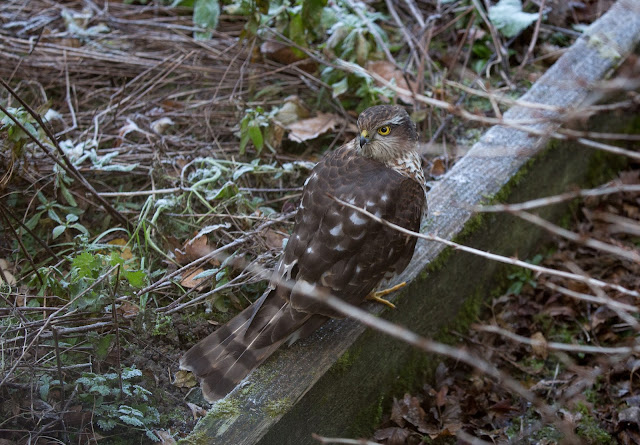It has been fascinating watching this sparrowhawk through my window in the last couple of weeks. Some days he arrives 20 minutes before sunrise and leaves 20 minutes after sunset, having spent much of the day in the kitchen garden. On other days I don't see him, although I don't (quite) spend all day watching through the window. His tactics vary - sometimes he sits for ages on the perch and waits to attack a bird flying in to the feeder. Or he flies fast circuits around the gooseberry bushes, trying to flush out the tits and sparrows hiding in the prickly branches. Sometimes he ends up on top of the feeder.
Sometimes he sits low down, presumably to make a better ambush. He is certainly well camouflaged.
Occasionally he climbs into the bush to try to grab a bird. He has to be careful not to sustain an injury as it would prove fatal if he wasn't able to hunt.
Here he's lining up the next attack.
Here he's on top of the bush with the birds just out of reach below.
Here he is on a kill. He tends to eat his kills immediately below the window which makes getting a clear view very difficult. This was taken with the iPhone.
I set up trail camera on a very frosty morning and got this view.
Sometimes he flies across the garden and sits on the fence for a while although I haven't seen him make a kill from there.
The reaction of the birds trapped in the gooseberry bushes is interesting. The blue tits are very agitated and hop around incessantly, calling alarms.
The sparrows sit very quietly, hardly moving and not making a sound.
I read that a male sparrowhawk needs to eat 4-5 blue tits or 2-3 sparrows every day to sustain himself. If hunting is going well it is all over in the first three or four hours of the day but this guy is still learning so he carries on until dusk. I have only ever seen him catch blue tits but I expect he catches other birds as well. I also read that a male sparrowhawk's winter territory is around 350 hectares which is the size of the whole of Gosforth Park. We regularly see an adult pair in the reserve so this chap could be one of this year's young, hanging around the edge of his parents' territory. Only a third of young sparrowhawks survive their first year. I hope this one makes it.














No comments:
Post a Comment